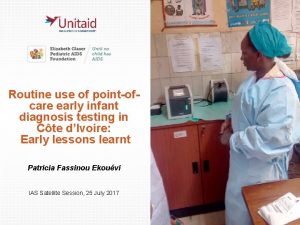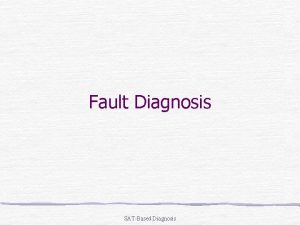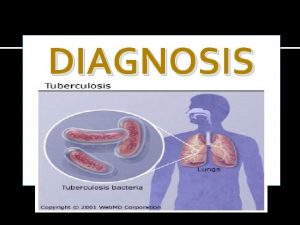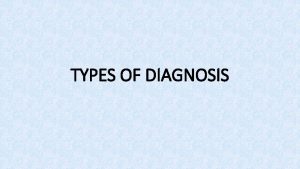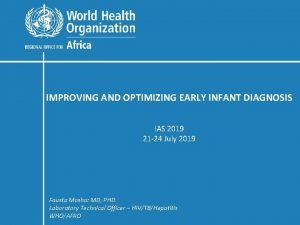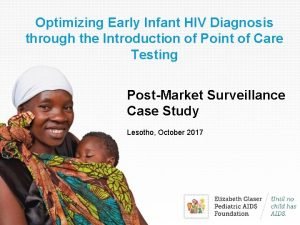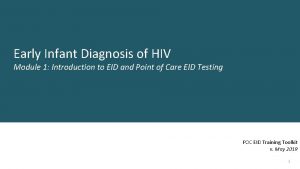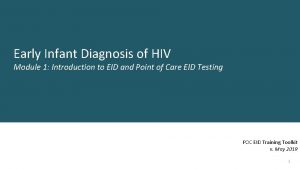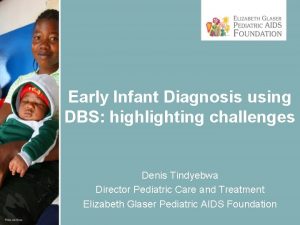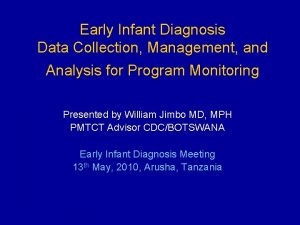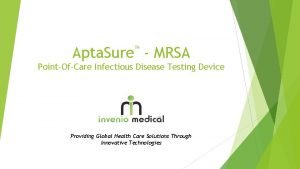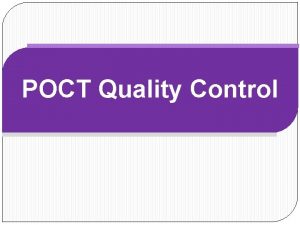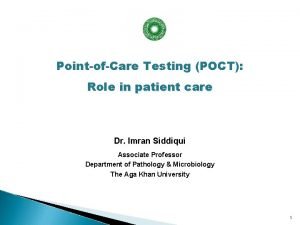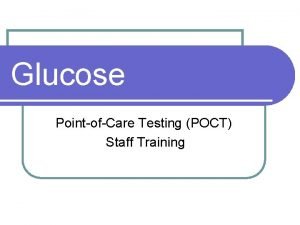Early Infant Diagnosis Impact of the pointofcare testing
























- Slides: 24

Early Infant Diagnosis - Impact of the point-of-care testing approach with Alere(tm) q HIV-1/2 Detect 9 th IAS Conférence on HIV Science (IAS 2017) 23 -26 July 2017 | Paris, France Palais des Congrès, 2 Place de la Porte Maillot, Paris Reuben Mwenda: MSc (Med Micro), HDMLS, CLT ASLM Ambassador Ministry of Health Malawi Government of Malawi 1

Presentation Outline 1 Background information 2 POC EID pilot 3 Testing beyond the pilot 4 Differentiated care models for EID 5 Balancing POC and conventional testing 6 Operational challenges 7 Conclusion and way forward 2

Background Information: Malawi HIV Statistics 1 Malawi has a population of 17, 750, 0001 2 Approximately 1. 1 million people are living with HIV 2 3 About 3, 339, 162 people were tested for HIV in 20163 4 There are 679, 056 people alive and on ART 3 5 Viral suppression rates among children (0 -14 years) and adults (15+ years) is 62% and 90%, respectively 3 Sources: 1. UN Data http: //data. un. org/Country. Profile. aspx? cr. Name=malawi 2. UNAIDS Estimates http: //www. unaids. org/en/regionscountries/malawi 3. Malawi HIV Quarterly Reports for Q 1, Q 2, Q 3 & Q 4 of 2016 3

Background Information: Malawi EID Program 1 Malawi has 671 health facilities that do HIV exposed child follow-up 2 Dried Blood Spot (DBS) sample collection for EID is done in all these sites 3 The country has 10 sites centralized molecular labs with conventional machines that provide EID testing 4 About 43, 784 EID tests were done in 20161 Source: 1. LIMS Data accessed at www. eidmalawi. org on 14 July 2017 at 11: 10 AM 4

POC EID Pilot: Loss to Follow Up (LTFU) of HIV Exposed Infants (HEI) In Malawi there was high LTFU of HEI before the implementation of POC EID 16000 14, 500 EID Program Snapshot, Q 2 2015 14000 12000 ~55% of expected HEI 10000 8000 6000 4000 2000 0 7, 992 ~36% of results returned within 2 months ~57% of results returned to patients ~48% of infected infants initiated 2, 871 1, 624 Number of DNA- Number of EID Expected HIVPCR Samples Results Received Results Exposed Infants Collected and at Sites Communicated Recorded to Mothers 181 87 Number of Positive EID Results Number of HIVInfected Infants <12 Mo. Initiated on ART ASLM Abstract Number: 2605753, Significantly improved Antiretroviral Therapy initiation rates after the implementation of Point Of Care Early Infant Diagnosis 5

POC EID Pilot: Design ØObjectives • To assess the operational characteristics of a POC device to inform an optimal national deployment strategy before scale up is done • To understand the patient impact of implementing POC EID technologies on test turnaround times, retention, and ART initiation ØMethods • Period: from September 2015 to June 2016 • Sites Selection: devices were placed at 7 sites • Baseline data: collected retrospectively for same number of months preceding EID POC implementation at POC sites ØStudy Population • Babies less than 12 months of age 6

POC EID Pilot: Site Selection ØInclusion criteria: 1 • High burden: HIV prevalence among pregnant women >10% at each site • High volume: High EID volumes maximize patient impact based on 2014 LIMS data • Strong buy-in: Sites expressed interested in implementing POC EID 3 • Patient / clinic flow: Facility-specific patient / clinic flow informed device placement strategies Central Hospital 2 District Hospital Primary Health Centre ØDevice placement strategies within a facility ✚ Testing at various entry points Device in a common lab 1 ✚ In-patient testing Device in pediatric ward 1 ✚ Testing from mother-infant-pair (MIP)clinic Device in MIP clinic 2 ✚ Testing all HEIs in peripheral low volume sites Device shared between 2 primary HCs or networked with peripheral sites 3 2 3 7

POC EID Pilot: Demographic Data The total number of infants tested was 1, 752 (both POC and centralized testing) Age of infants <2 months 2 -6 months 6 -12 months >12 months Missing info Proportion 56% (n=987) 31% (n=536) 11% (n=191) 1% (n=21) 1% (n=17) Sex Male Female Missing info Proportion 46% (n=799) 50% (n=870) 5% (n=83) 8

POC EID Pilot: Device Utilization Device utilization: District hospitals appear to be the “sweet spot” for POC EID, while device sharing by rural health centres can maximize device utilization as well Device utilization by type of facility during the study period Facility Type by Device Number of POC Proportion of Total Tests Placement Tests/Site ART clinic - Central Hospital 103 13% Pediatric Ward -Central hospital 82 10% Lab – District hospital 216 27% Mother Infant Pair Clinic – District hospital 156 20% Rural Health Centre 61 8% Rural HC Sharing 171 22% Total 789 100% 9

POC EID Pilot: Entry Point Deployment POC is likely to help find more HIV positive infants when deployed in the pediatric wards Proportion of HIV Positive Infants by entry point within a clinic during the study period Entry Point HIV Test Result Total Positive (%) 694 2% Positive 17 Negative 677 Pediatric Ward - Inpatient 22 23 45 49% Pediatric Ward - Outpatient 6 44 50 12% 45 744 789 6% PMTCT/ART/MIP Total 10

POC EID Pilot: Patient Impact POC EID allows for significantly reduced test turnaround times along the testing and treatment cascade as well as improved ART initiation rates Conventional POC TAT: sample collection to results received 56 days Same day TAT: sample collection to ART initiation (positive infants only) 38 days Same day 41% 100% 45. 8% 91. 1% Proportion of results received within 60 days Proportion of HIV+ patients starting ART ASLM Abstract Number: 2605753, Significantly improved Antiretroviral Therapy initiation rates after the implementation of Point Of Care Early Infant Diagnosis 11

POC EID Pilot: Perceptions of Healthcare Workers è A total of 32 healthcare workers were trained on how to operate Alere q è A sample of 20 healthcare workers were interviewed to get their perceptions on Alere q Type of Cadre Clinician 5 HSAs 3 HTC Counsellor 6 Lab Tech 1 Microscopist 1 Nurse/Midwife 3 Others-HDA 1 Total 20 12

POC EID Pilot: Perceptions of Healthcare Workers èHCW who found all aspects of running tests relatively easy How easy is the test to perform? Heel-stick Respondents: 20 Cartridge Inserting Ejecting the filling cartridge in the cartridge device Average 5% Average Easy 30% Easy Very easy 65% Very easy 0 Average 45% Easy 55% Very easy 5% Average 35% Easy 60% Very easy Interpreting the results 0 Average 40% Easy 0 30% 60% Very easy 70% 13

POC EID Pilot: Perceptions of Healthcare Workers… èPOC tests have helped facilities better treat and manage HIV+ infants The POC test helped facility better treat and manage HIV+ infants No. of HCW Percentage No 1 5% Yes 19 95% èDivided opinion on device portability Portability of device No. of HCWs Percentage No 9 45% Unsure Yes 2 9 10% 45% 14

POC EID Pilot: Perceptions of Healthcare Workers… èNon-lab staff are suitable to run tests Non lab-staff suitable to run the test? No No. of HCWs Percentage 1 5% Yes 19 èTest is suitable at all facility levels 95% At which facility level of care the test is suitable? No. of HCWs 11 Percentage 55% Central Hospitals 1 5% Health center 8 40% All levels 15

Testing Beyond the Pilot In Sep 2015 -April 2017 a total of 2, 542 EID tests were done Total Tests Positive Tests Negative Tests Totals 2, 542 146 2, 396 Percentage 100% 5. 74% 94. 26% 16

Differentiated Care Models for EID è Need to retain capacity to respond to patients who present with advanced disease, and are at heightened risk of morbidity and mortality 4 è Shorter TAT has a positive effect on provider initiated testing and counseling (PITC) 5 è “In generalized epidemic settings, infants and children with unknown HIV status who are admitted for inpatient care or attending malnutrition clinics should be routinely tested for HIV” 6 è Generally expedited DNA PCR testing was used on conventional machines and TAT was more than 3 days Therefore, conventional EID testing would be more suitable for stable HIV exposed infants while unstable/sick HIV exposed infants would more likely require expedited model of testing Alere q has been used to provide a differentiated care model for patients needing expedited testing, same day results so that clinicians can decide the next course of action 4. Mortality of HIV-1 -infected patients in the first year of ART: comparison between low-income and high-income countries. . Lancet, 2006; 367(9513): 817– 24; 5. Mc. Collum et al, 2014; 6. Highlights: AIDS 2016 ASLM Satellite Session: Implementing POC for Early Infant Diagnosis Testing; 17

Differentiated Care Models for EID… POC EID minimizes loss to follow up by turning multiple clinic visits into one visit and by reducing the turnaround time to same day results Same day HIV+ Mother and Infant Enrollment of HEI to HIV care Fill lab requisition for EID 2 3 1 EID Test performed on site 4 Test result received, recorded 5 Same day Clinical consultation 6 ART initiation 7 18

Balancing POC and Conventional Testing è Malawi has 10 centralized labs providing EID and VL testing è Based on POC mapping results, POC can cover 25% of national EID testing needs and conventional and near POC can cover 75% of the remaining need POC EID sites also rely on conventional laboratories for duplicate testing in EQA 19

Operational Challenges During Implementation of POC EID Tracking ART initiation of referrals When infants are managed by a referring facility Children discharged/transferred Poor out from inpatient care documentation immediately after a test and weak linkages before initiating treatment Device down times Absence of a local service and maintenance point Proposed Solutions Testing facility should initiate HIV positive infants on treatment and advise mothers to collect subsequent refills at the referring facility Intensify training of healthcare workers on proper documentation Institute electronic patient tracking systems Build and strengthen local capacity 20

Operational Challenges During Implementation of POC EID Short shelf-life of test cartridges Delayed in-patient initiation Current shelf-life for POC cartridges is 9 months as compared to 18 months for HIV rapid test kits Delayed initiation of treatment among HIVpositive infants receiving inpatient care due to unstable medical conditions Proposed Solutions Advocate for longer shelf-life (18 months) Strengthen follow up mechanism ts to make sure that there is no delay in initiation of treatment as soon as the patient gets stable 21

Conclusion and Way Forward • ART initiation rates were significantly improved with the implementation of POC EID testing compared to conventional laboratory-based testing • Turnaround time has greatly improved • Testing infants in pediatric wards yielded significant positive results therefore placement of the devices in these sites is vital • Clinical management of infants found outside of PMTCT is critical and needs to be thought through to ensure they are linked to care accordingly Wider decentralization of POC EID would allow for wider access to EID testing, support increased ART initiation, and improve patient outcomes • Non-laboratory staff can successfully implement POC EID • • National deployment strategy for POC is important; MOH is in the process • Overall, this is great input to the attainment of global 90 -90 -90 targets 22

Acknowledgements • • • UNITAID UNICEF CHAI CDC/PEPFAR URC USAID ASLM MSF EGPAF 23

Agenda Feedback? Questions? Zikomo! Thank You! 24 Government of Malawi
 Nursing process steps
Nursing process steps Medical diagnosis and nursing diagnosis difference
Medical diagnosis and nursing diagnosis difference Second phase of nursing process
Second phase of nursing process Types of nursing diagnoses
Types of nursing diagnoses Perbedaan diagnosis gizi dan diagnosis medis
Perbedaan diagnosis gizi dan diagnosis medis Social impact statement for early design review
Social impact statement for early design review Ecrq journal
Ecrq journal Social impact statement for early design review
Social impact statement for early design review Early cpr and early defibrillation can: *
Early cpr and early defibrillation can: * Domain testing in software testing methodologies
Domain testing in software testing methodologies Logic based testing
Logic based testing Du path testing
Du path testing Positive negative testing
Positive negative testing Cs 3250
Cs 3250 Globalization testing in software testing
Globalization testing in software testing Neighborhood integration testing
Neighborhood integration testing Cause effect graph for triangle problem
Cause effect graph for triangle problem Control structure testing in software testing
Control structure testing in software testing Decision table testing in software testing
Decision table testing in software testing Decision table testing example
Decision table testing example Error yang dapat diketahui dari pengujian black box adalah
Error yang dapat diketahui dari pengujian black box adalah Behavioral testing adalah
Behavioral testing adalah Decision table based testing in software testing
Decision table based testing in software testing Rigorous testing in software testing
Rigorous testing in software testing Testing blindness in software testing
Testing blindness in software testing

























